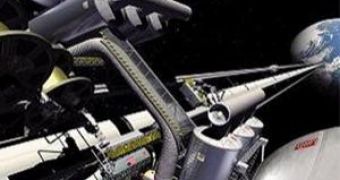The space elevator has been regarded as a cheaper alternative to carrying crew, equipment or even spacecraft into space, instead of using high-cost rockets to do the job. The lift would consist of a cable (also referred to as a tether or a ribbon) to be anchored to the planet's surface at one end and to a space-based counterweight at the other, with a "climber" powered by lasers going up and down. But recent studies have proved that the actual process of hauling things up the cable would cause it to shake and swing dangerously up to a point where it would collide with satellites or debris in the area.
The constant tugs from the Sun's or the Earth's gravity, the solar wind or, as the new study shows, even the wobbles a cargo would force on the cable as it went up would make the tether highly unstable, given the effect of the Coriolis force. This force deflects items that are in motion (water, air or, in this case, the elevator's "climber") within a rotating system (the Earth), which would pull the cable and the load in a direction opposite to the planetary rotation.
This would cause the elevator to swing like a pendulum, possibly only by fractions of a degree, state mechanical engineers Arun Misra, from McGill University in Montreal, Canada, and Stephen Cohen, from MDA Space. But that would be enough to reduce the speed of a carried spacecraft to be launched from the elevator, and to alter its course by tens of kilometers, requiring large quantities of fuel to correct it.
The most obvious solution is significantly slowing down the elevator so that it stays perfectly vertical above the planet's equator, but reaching the destination could then take nine more days over the estimated trip time, which was taking 15 days in the first place. An alternative to this would be speeding up progressively or sending more "climbers" at the same time, in a perfect synchronization.
"I would say that it is too early to establish the best way to do this," shared David Lang, a consultant from Seattle, Washington, to New Scientist. But "Needing to impose a particular climber schedule and speed could have implications for the economical viability of a space elevator, so it is a very important question to answer," explained Anders Jorgensen from the New Mexico Institute of Mining and Technology in Socorro, US.

 14 DAY TRIAL //
14 DAY TRIAL //